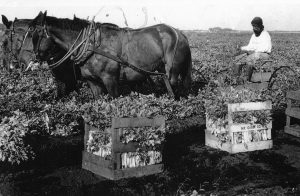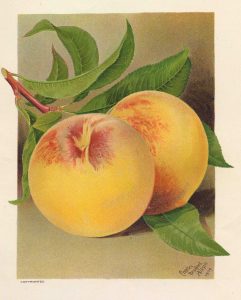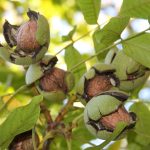
Puna Singh Cheema Farming Celery, CA, 1922. Photo Courtesy of Ted Sibia and the South Asian Americans in North America Collection, Bancroft Library, UC Berkeley.
Punjabi Americans have contributed a great deal to the development of agriculture throughout the state of California, particularly in the San Joaquin, Sacramento and Imperial Valleys. In the early twentieth century, Punjabi pioneers helped initiate rice cultivation in the northern Sacramento Valley, grew grapes and many other crops near Stockton, and helped establish cotton growing in the Imperial Valley. They were also engaged in farming in many states in the western region of North America from British Columbia in Canada to California, Washington, Oregon, Utah, and Arizona in the US.
Early Contributions (1899-1940s)
The early pioneers earned a reputation for hard work, reliability, and ingenuity in developing agricultural techniques to improve farming. The Punjabis were quite proficient in clearing and irrigating land, pruning trees, and picking specialty fruits.
There are several contemporary accounts in the early twentieth century noting the Punjabis’ inventiveness with irrigation techniques. In Arizona in 1920, Gopal Singh and other Punjabis started raising cotton. The local Chandler Arizona newspaper noted how Gopal introduced irrigation techniques in the local area that led to the successful cultivation of cotton in an arid climate:
The 400 acres of cotton didn’t receive a bit of water until May 12th. Seeds came through without water under a system of planting which Gopal learned from his father in far off India, where dire necessity in lack of water resulted in finding a way to bring up vegetation by attracting underground moisture.
(Das, Hindustani Workers on the Pacific Coast, 44)
When the early pioneers arrived in California in the early twentieth century, most were illiterate, did not speak English, and possessed few resources. Within a short time, however, the majority of the Punjabi pioneers became tenant farmers leasing ranches from one to three years. Some were even able to purchase land of their own. With the application of the Alien Land Laws to the Punjabi farmers after the US v Thind Supreme Court decision, they could no longer own or lease land between 1923 and 1946. During these difficult decades with the Great Depression and the inability to own land, the Punjabi farmers entered into informal farming arrangements with white American farmers, bankers, and businessmen.
Farming in the Postwar Era (Late 1940s-Present)

Courtesy of the California State Library, Sacramento.
The Yuba City area is one of the most productive agricultural areas in California in crops such as peaches, plums, walnuts, prunes, and rice. Most of the rice production in California occurs in the Sacramento Valley, including Sutter County. In addition, other crops grow well in the area — grapes, hay, grains, olives, pears, and certain types of citrus.
It is only in the post-World War II period that Yuba City/Marysville became the most important center of farming for Punjabi American farmers in California (although the San Joaquin Valley also remains a vibrant farming area for the community). The most important catalyst for the shift in Punjabi farming to the Sacramento Valley was the changing US immigration and citizenship policy. After the passage of the 1946 Luce-Cellar Act, the Punjabi immigrants were allowed to become naturalized US citizens, and by extension were entitled to all of the rights of a citizen, including land ownership. It took over a decade for this new federal legislation and the repeal of California’s Alien Land Law in 1956 to make a substantial impact on the community.
After the passage of the Luce-Cellar Act, a small number of Punjabi American farmers successfully purchased land. Cling peaches and other orchard crops provided the financial basis to bring their relatives from India and expand their family farm operations. According to Bruce La Brack’s sociological study, The Sikhs of Northern California, “The smaller peach orchard of from 20 to 30 acres was the base upon which Punjabis built their present holdings. The Sikh agricultural families’ low personal expenses and cooperative hard work made the peach growing enterprises competitive.” The peach crop held a special importance for the Punjabi community because it required a small amount of initial capital, and with hard work, a profit could be achieved relatively quickly. According to the Cling Peach Advisory Board, Punjabi American farmers controlled 25% of the Sacramento Valley production of peaches during the 1970s (La Brack, 296-97).
From the economic base provided by orchard farming, the Punjabi Americans gained a new-found independence from which they could decide how and to what extent they would participate in the broader American society. With their success in orchard farming, they sponsored many relatives from India, paying for their travel and immigration expenses and giving them immediate employment and shelter. The newcomers contributed to the growing family-owned farm operations and generally purchased their own farms eventually. According to a prominent local farmer, Kulwant Johl, Punjabi Americans currently produce approximately 95% of the cling peaches, 50% of the prunes, 20% of the walnuts, and 15% of the almonds in the Yuba City area. Punjabi American farmers also serve in leadership positions on the Yuba Sutter Farm Bureau, the California Cling Peach Board, and numerous other agricultural boards in northern California.
An Example of Today’s Agribusiness: Sacramento Valley Walnut Growers, LLC.

Bursting Walnuts. Courtesy of Sarbjit Johl.
In recent years, Punjabi American farmers have diversified their crops and engaged in large-scale agribusiness operations. Sacramento Valley Walnut Growers, LLC. is a grower-owned processor and marketer of California walnuts. The business was founded in 2006 by Punjabi American farmer, Sarbjit Johl, as a vehicle to market the walnuts grown by his family’s business. Accompanied by a small group of other family farmers as partners, the group has become fully vertically integrated taking their walnuts from the orchard to the box. Inshell and shelled walnuts are marketed globally serving the retail, food service and ingredient sectors. Sacramento Valley Walnut Growers has developed a sophisticated, state of the art processing facility and established itself as a quality brand (http://www.sacvalleynut.com). Sarbjit Johl is the Chairman of the California Cling Peach Board, and he recently won the Agriculturalist of the Year Award at the California State Fair in July 2016.
SOURCES:
Das, Rajani Kanta. Hindustani Workers on the Pacific Coast (Berlin and Leipzig: Walter de Gruyter & Co, 1923).
La Brack, Bruce. The Sikhs of Northern California: 1904-1975 (New York: AMS Press, 1988).
Leonard, Karen Isaksen. The South Asian Americans (Westport, CT: Greenwood Press, 1997).
To learn more about the Sacramento Valley Walnut Growers, LLC, visit: https://dfaofca.com/newsletter/2016-08/announcing-the-pinnacle-club-plant-of-the-year-sacramento-valley-walnut-growers/
To read about Sarbjit Johl’s Agriculturalist of the Year Award, 2016, view: http://calclingpeach.com/california-cling-peach-board-chairman-sarbjit-sarb-johl-is-awarded-2016-agriculturalist-of-the-year/
